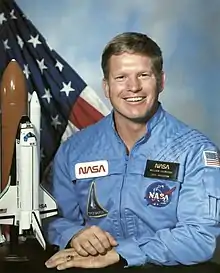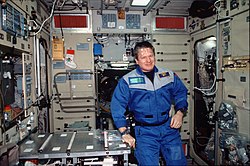William M. Shepherd | |
|---|---|
 | |
| Born | William McMichael Shepherd July 26, 1949 Oak Ridge, Tennessee, U.S. |
| Status | Retired |
| Nationality | American |
| Other names | Bill Shepherd |
| Alma mater | United States Naval Academy (BS, 1971) Massachusetts Institute of Technology (EOE, 1978; MS, 1978) |
| Occupations | |
| Awards | |
| Space career | |
| NASA Astronaut | |
| Rank | |
Time in space | 159d 07h 49min |
| Selection | 1984 NASA Group 10 |
| Missions | STS-27, STS-41, STS-52, Soyuz TM-31, Expedition 1, STS-102 |
Mission insignia | |
| Retirement | August 14, 2002 |
William McMichael "Bill" Shepherd (born July 26, 1949), (Capt, USN, Ret.), is an American former Navy SEAL, aerospace, ocean, and mechanical engineer, and NASA astronaut, who served as commander of Expedition 1,[1] the first crew on the International Space Station. He is a recipient of the Congressional Space Medal of Honor.[2]
Education and training
Shepherd was born on July 26, 1949, to George R. Shepherd and Barbara Shepherd in Oak Ridge, Tennessee, but he considers Babylon, New York, his hometown.[1] He is married to Beth Stringham of Batavia, New York.[3] He graduated from Arcadia High School in Phoenix, Arizona in 1967, and received a Bachelor of Science degree in Aerospace Engineering from the United States Naval Academy in Annapolis, Maryland in 1971.[4] He completed Basic Underwater Demolition/SEAL (BUD/S) training in 1972, then joined the United States Naval Special Warfare Command and qualified as a Navy SEAL. He served with the Navy's Underwater Demolition Team ELEVEN, SEAL Teams ONE and TWO, and Special Boat Unit TWENTY. He obtained an Engineer's degree in Ocean Engineering and a Master of Science degree in Mechanical Engineering, both in 1978, from the Massachusetts Institute of Technology (MIT).[1][4]
NASA career
When I was little I used to cut up two-by-fours and make little boats. I'm still in the boat-building business. It's just in orbit.
—William M. Shepherd.[5]


After Shepherd was selected for NASA Astronaut Group 10 in 1984,[6] rumors spread that he had answered a standard interview question about what he did best by saying, "kill people with knives"[7] but he later refused to confirm or deny the account, commenting "it's too good a story".[8] He was the first military non-aviator in astronaut training, following his unsuccessful application for NASA Astronaut Group 9 in 1980.[9] In 1986, Shepherd's Navy SEAL training proved unexpectedly useful to NASA as he helped to direct the underwater salvage operations of the Space Shuttle Challenger after its destruction. Shepherd then served as a mission specialist on three Space Shuttle flights: mission STS-27 in 1988,[10] mission STS-41 in 1990,[11] which deployed the Ulysses probe, and mission STS-52 in 1992.[12] He was the first member of NASA Astronaut Group 10 to fly a space mission.
From March 1993 to January 1996, he was assigned to the International Space Station Program,[4] serving as Program Manager and Deputy Program Manager. In November 1995 he was selected to command the first crew of the International Space Station (ISS). The mission was supposed to launch in 1997,[13] but a long series of political, financial, and technical problems caused significant delays. Although sixteen nations would participate in the ISS program, Russia, along with the United States would bear the majority of the station's costs.[5]
Spaceflight experience
STS-27: Atlantis (December 2–6, 1988) Shepherd served with his crewmates on a mission that lasted 105 hours and carried Department of Defense payloads. The mission is noteworthy due to the severe damage Atlantis sustained to its critical heat-resistant tiles during ascent.[14][15][10]
STS-41: Discovery (October 6–10, 1990) during 66 orbits of the Earth, the crew aboard the Orbiter successfully deployed the Ulysses, starting it on a four-year journey (via Jupiter) to investigate the polar regions of the Sun.[11][16]
STS-52: Columbia (October 22 to November 1, 1992) was the 10-day mission deployed the Laser Geodynamic Satellite (LAGEOS), and conducted U.S. microgravity payload experiments.[17][12]
Expedition 1: From October 31, 2000,[18] to March 21, 2001,[19] he and Russian cosmonauts Yuri Gidzenko and Sergey Krikalev launched from Baikonur on Soyuz TM 31 and served as Expedition 1, the first crew on board ISS. The crew returned to Earth on the Space Shuttle Discovery, STS 102.[19]
Post-NASA career
Shepherd was next assigned to the staff of Commander, Naval Special Warfare Command,[5] to assist with the development of new capabilities and programs for the Navy's SEAL and Special Boat units. He retired from the U.S. Navy in January 2002.[5] CAPT Shepherd also served as U.S. Special Operations Command's first Science Advisor from 2008–2011.[20]
Organizations
Awards and honors

- Congressional Space Medal of Honor[2]
- NASA's "Steve Thorne" Aviation Award
- 2004 inductee into the International Space Hall of Fame[21]
- 2009 inductee into the U.S. Astronaut Hall of Fame.[22]
- Honorary Naval Aviator[23]
- Fédération Aéronautique Internationale V. M. Komarov Diploma[24]
- Fédération Aéronautique Internationale (FAI) Yuri Gagarin Gold Medal[25]
- Spirit of St Louis Medal[26]
- Dr. Robert H. Goddard Memorial Trophy[27]
- Medal "For Merit in Space Exploration"[28]
- In 2009, the International Space Station Program team, which Capt. Shepherd led both on the ground, and in space, was awarded the Collier Trophy.[29]
References
![]() This article incorporates public domain material from websites or documents of the National Aeronautics and Space Administration.
This article incorporates public domain material from websites or documents of the National Aeronautics and Space Administration.
- 1 2 3 4 Lyndon B. Johnson Space Center (January 2002). "William M. Shepherd" (PDF). Biographical Data. Houston, Texas: NASA. Archived (PDF) from the original on May 4, 2021. Retrieved May 4, 2021.
- 1 2 Mahone, Glenn; Jacobs, Bob (July 23, 2004). "S04-238: Challenger Crew Honored With Congressional Space Medal Of Honor". NASA News. Washington, D.C.: NASA. Archived from the original on May 4, 2021. Retrieved May 4, 2021.
- ↑ Lyndon B. Johnson Space Center (February 2004). "Beth Ann Stringham Shepherd" (PDF). Biographical Data. NASA. Archived (PDF) from the original on May 4, 2021. Retrieved May 4, 2021.
- 1 2 3 Garber, Stephen J.; Launius, Roger (May 8, 2001). "Looking Backward, Looking Forward: Forty Years of US Human Spaceflight Symposium" (PDF). NTRS - NASA Technical Reports Server. NASA. p. 228. Archived (PDF) from the original on May 4, 2021. Retrieved May 4, 2021.
- 1 2 3 4 "Capt. William Shepherd: First Commander of the International Space Station". Hall of Fame. Alamogordo, New Mexico: New Mexico Museum of Space History. 2004. Archived from the original on May 4, 2021. Retrieved May 4, 2021.
- ↑ Lawrence, John (May 23, 1984). "84-028: NASA Select 17 Astronaut Candidates" (PDF). NASA News. Houston, Texas: NASA. p. 66. Archived (PDF) from the original on May 4, 2021. Retrieved May 4, 2021.
- ↑ Kelly, Scott; Dean, Margaret Lazarus (2017). Endurance: A Year in Space, A Lifetime of Discovery. London: Transworld Publishing. p. 186. ISBN 9781473543195.
- ↑ Leary, Warren E. (November 3, 2000). "Men in the News; The Crew of the International Space Station". New York Times. Archived from the original on May 4, 2021. Retrieved May 4, 2021.
It's just too good a story to deny,
- ↑ Kauderer, Amiko (October 28, 2010). "Preflight Interview: William Shepherd". International Space Station. NASA. Archived from the original on May 4, 2021. Retrieved May 4, 2021.
- 1 2 Ryba, Jeanne (November 23, 2007). "STS-27". Mission Archives. NASA. Archived from the original on May 4, 2021. Retrieved May 4, 2021.
- 1 2 Ryba, Jeanne (February 18, 2010). "STS-41". Mission Archives. NASA. Archived from the original on May 4, 2021. Retrieved May 4, 2021.
- 1 2 Ryba, Jeanne (March 31, 2010). "STS-52". Mission Archives. NASA. Archived from the original on May 4, 2021. Retrieved May 4, 2021.
- ↑ Dempsey, Robert (April 13, 2018). "The International Space Station: Operating an Outpost in the New Frontier" (PDF). NASA. p. xiv. Archived (PDF) from the original on May 4, 2021. Retrieved May 4, 2021.
- ↑ Jasper, G. L.; Johnson, D. L.; Batts, G. W. (July 1989). "Atmospheric environment for Space Shuttle (STS-27) launch" (PDF). NTRS - NASA Technical Reports Server. NASA. Archived (PDF) from the original on May 4, 2021. Retrieved May 4, 2021.
- ↑ Riley, Jack (September 15, 1987). "87-043: STS-27 Crew Named" (PDF). NASA News. Houston, Texas: NASA. p. 101. Archived (PDF) from the original on May 4, 2021. Retrieved May 4, 2021.
- ↑ Camp, David W.; Germany, D. M.; Nicholson, Leonard S. (November 1990). "STS-41: Space Shuttle Mission Report" (PDF). NTRS - NASA Technical Reports Server. NASA. Archived (PDF) from the original on May 4, 2021. Retrieved May 4, 2021.
- ↑ Fricke, Robert W. Jr. (December 1992). "STS-52: Space Shuttle Mission Report" (PDF). NTRS - NASA Technical Reports Server. NASA. Archived (PDF) from the original on May 4, 2021. Retrieved May 4, 2021.
- ↑ Petty, John Ira (October 31, 2000). "International Space Station Status Report #00-43". Johnson News. Houston, Texas: NASA. Archived from the original on May 4, 2021. Retrieved May 4, 2021.
- 1 2 Petty, John Ira (March 21, 2001). "STS-102 Mission Control Center Status Report # 27". Johnson News. Houston, Texas: NASA. Archived from the original on May 4, 2021. Retrieved May 4, 2021.
- ↑ "CAPT William M. Shepherd". Advisory Board. Systems Engineering Research Center. Retrieved May 4, 2021.
- ↑ "X-Prize group founder to speak at induction". El Paso Times. Alamogordo, New Mexico: Gannett. Alamogordo Daily News. October 17, 2004. p. 59. Archived from the original on May 4, 2021. Retrieved May 4, 2021 – via Newspapers.com.
- ↑ "William Shepherd". Astronanaut Hall of Fame. Orlando, Florida: Astronaut Scholarship Foundation. May 2, 2009. Archived from the original on May 4, 2021. Retrieved May 4, 2021.
- ↑ "William M. Shepherd". ihmc.us. Florida Institute for Human and Machine Cognition. Archived from the original on May 4, 2021. Retrieved May 4, 2021.
- ↑ "Keynote Speakers". cser.info. Conference on Systems Engineering Research. 2019. Archived from the original on May 4, 2021. Retrieved May 4, 2021.
- ↑ "CAPT. William M. Shepherd, USN". Symposium 365 Speakers. Colorado Springs, Colorado: Space Foundation. Archived from the original on May 4, 2021. Retrieved May 4, 2021.
- ↑ "Spirit of St. Louis Medal". ASME.org. New York City: American Society of Mechanical Engineers. Archived from the original on May 4, 2021. Retrieved April 7, 2019.
- ↑ "Past Goddard Trophy Winners". spaceclub.org. Washington, D.C.: National Space Club. Archived from the original on May 4, 2021. Retrieved May 4, 2021.
- ↑ Kowsky, Joel (December 2, 2016). "Former Astronaut William Shepherd Awarded Russian Medal for Merit in Space Exploration". Flickr. NASA. Archived from the original on May 4, 2021. Retrieved May 4, 2021.
- ↑ Kauderer, Amiko (May 13, 2010). "NASA's International Space Station Program Wins Collier Trophy". International Space Station. NASA. Archived from the original on May 4, 2021. Retrieved May 4, 2021.
